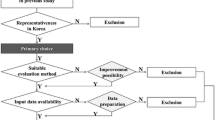Abstract
The forest ecosystem of the Changbai Mountain is the most typical upland temperate forest ecosystem in eastern Asia. It is also of the most primitive vegetation type that came into being through the natural succession of soil and vegetation following volcanic eruption. The forest ecosystem has great importance for maintaining the structures and functions of the watershed ecosystems of the Songhua River, the Yalu River and the Tumen River. We combined physical assessment method (PAM) with the value assessment method (VAM) to evaluate the forest ecosystem services of the northern slope of the, including eco-tourism, forest by-products, timber, soil and water conservation, air purification, and the recycling of nutritive elements. We also assessed the integrated forest ecosystem service and analyzed its dynamics. The service value provided by the Changbai Mountain forest ecosystem amounts up to RMB 3.38 × 1012 yuan, of which, water conservation is 66%, water conservation and air purification together make up 80%, while the timber value is only 7%. Therefore, developing the ecosystem services besides timber is the best way to exert the integrated value of the forest ecosystem services of Changbai Mountain.
Similar content being viewed by others
References
Daily, G., What are ecosystem services? in Natures Services: Societal Dependence on Natural Ecosystems (ed. Daily, G.), Washington, DC: Island Press, 1997, 1–10.
Harold, A. M., Paul, R. E., Ecosystem services: A fragmentary history, in Natures Services: Societal Dependence on Natural Ecosystems (ed. Daily, G.), Washington: Island Press, 1977, 11–28.
Costanza, R., Arge, R. D., Groot, R. D. et al., The value of the world’s ecosystem services and natural capital, Nature, 1997, 387: 253–260.
Alexander, S., Schneider, S., Lagerquist, K., Ecosystem services: interaction of climate and life, in Nature’s Services: Societal Dependence on Natural Ecosystems (ed. Daily, G.), Washington, DC: Island Press, 1997, 71–92.
Bormann, F., Likens, G., Fisher, D., Nutrient loss accelerated by clear-cutting of a forest ecosystem, Science, 1968, 159: 882–884.
Pimentel, D., Harvey, C., Resosudarmo, P., Environmental and economic costs of soil erosion and conservation benefits, Science, 1995, 267: 1117–1123.
Xue Dayuan, Economic Valuation of Biodiversity: A Case Study on Changbai Mountain Biosphere Reserve in Northeast China (in Chinese), Beijing: China Environmental Science Press, 1997, 11–103.
Zhao Shidong, Biodiversity and conservation in Changbai Mountain biosphere reserve, Ambio, 1999, 28(8): 639–641.
Wu Gang, Dai Limin, Structure and dynamics of a temperate deciduous conifer mixed forest in Changbai mountain, Acta Ecologica Sinica, 1998, 18(5): 470–477.
Yang Hanxi, Li Dingjia, Wang Bennan et al., Spatial patterns of principal trees of the Korean-pine broadleaf forest at Changbai Mountain, in Forest Ecosystem Research (in Chinese), Vol. 5, Beijing: China Forestry Publishing House, 1985, 1–14.
Fu Lixun, Improving Ecological Environment (in Chinese), Beijing: Scientific Books and Periodicals Press, 1989, 43–44.
Pei Tiefan, Fan Shixing, Han Shaowen et al., Hyorological function and simulation of the broad leaved Korean pine forest in Changbai Mountain, Acta Ecologica Sinica (in Chinese), 1995, 15(Supp. B): 113–119.
Li Wenhua, The biomass of main forest ecosystem of Changbai Mountain, in Forest Ecosystem Research (in Chinese), Vol. 2, Beijing: China Forestry Publishing House, 1981, 34–50.
Xu Guangshan, Zhang Yuhua, Liu Chunping, Biological nutrient cycling in a Korean pine-spruce-fir forest stand in Changbai Mountain, Acta Ecologica Sinica (in Chinese), 1995, 15(Supp. B): 54–60.
Li Wenhua, Deng Kunmei, Shao Bin et al., Studies on the community characteristics of dark conifer forest of Changbai Mountain, in Forest Ecosystem Research (in Chinese), Vol. 7, Beijing: Knowledge Press, 1995, 1–15.
Chen Dake, Feng Zongwei, Vegetation in the alpine and subalpine zone of the Changbai Mountain area, in Forest Ecosystem Research (in Chinese), Vol. 5, Beijing: China Forestry Publishing House, 1985, 49–56.
Qian Hong, Liu Qijing, Shao Guofan et al., Preliminary study on synecology of early-spring herbs in broadleaved-Korean pine forest of the Changbai Mountain, in Forest Ecosystem Research (in Chinese), Vol. 6, Beijing: China Forestry Publishing House, 1992, 31–44.
Zhao Jingzhu, Xiao Han, Wu Gang, Comparison analysis on physical assessment method and value assessment method for ecosystem services, Chinese Journal of Applied Ecology (in Chinese), 2000, 11(2): 290–292.
Wu Gang, Regeneration dynamics of tree species in gaps of Korean pine broad-leaved mixed forest in Changbai Mountain, Chinese Journal of Applied Ecology (in Chinese), 1998, 9(5): 449–452.
Author information
Authors and Affiliations
Corresponding author
Rights and permissions
About this article
Cite this article
Wu, G., Xiao, H., Zhao, J. et al. Forest ecosystem services of changbai mountain in china. Sci. China Ser. C.-Life Sci. 45, 21–32 (2002). https://doi.org/10.1360/02yc9003
Received:
Issue Date:
DOI: https://doi.org/10.1360/02yc9003




